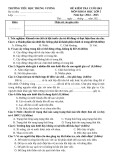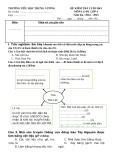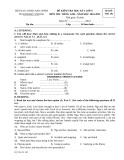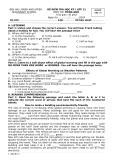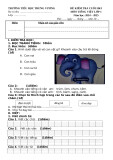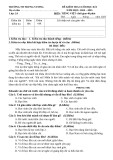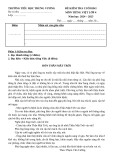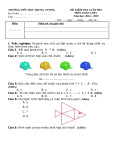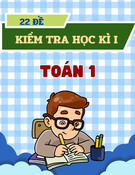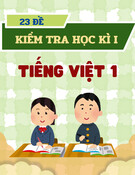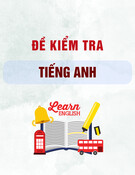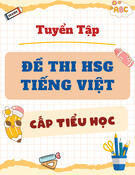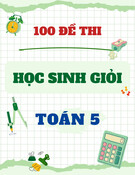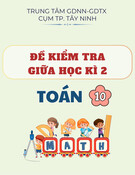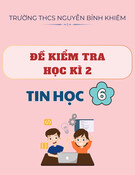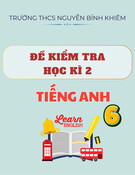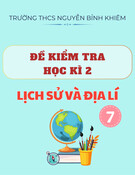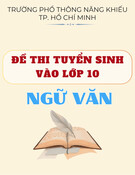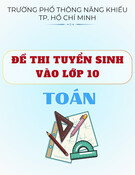Ể
Ộ Ấ ƯỜ Ọ PHÒNG GD & ĐT TRÀNG Đ NHỊ NG TH, THCS Đ I C N TR Ố Ọ BÀI KI M TRA CU I H C KÌ I NĂM H C 2021 2022
́
21
̀ ̉ ơ ơ ́ơ 5 ) MÔN TIÊNG ANH ( L p ́ ̀ Ngay................thang............năm 20 ̀ ̀ ́ ( Không kê th i gian giao đê ) Th i gian: 40 phut
Name:........................................................... Class: 5.......School: Doi Can primary school.
Mark Comments of teacher
I. LISTENING
Task 1. Listen and tick .
1
B. A.
2
A. B.
3
B. A.
4
B. A.
Task 2. Listen and number the pictures.
1
C. A. B. D.
Task 3. Listen and match
A B C D
II. READING AND WRITING
1.Read and circle a or b
Linda usually goes to school in the morning. Yesterday, she didn’t go to school because it was Sunday. She went shopping with her mother after breakfast. They shopped for food and drink and a lot of things for the family. In the afternoon, the family visited Linda’s grandparents in the countryside. The grandparents were very happy to see them. The family enjoyed their day in the countryside and went back home in the evening. Next week, they will visit Linda’s grandparents again.
1.What does Linda usually do in the morning?
a. She does morning exercise.
b. She goes to school.
2.Did she go to school yesterday?
a. Yes, she did.
2
b. No, she didn’t.
3.Where did she go in the morning?
a. She went shopping.
b. She went to the countryside.
4.Where do Linda’s grandparents live?
a. In the city.
b. In the countryside.
2.Read and write
My name is Nam. I go to school from Monday to Friday. I have Maths and Vietnamese every schoolday. I have English four times a week. English is my favourite subject. I practise reading by reading English comic books and storybooks. Now I can read Aladdin and the Magic Lamp in English. I practise speaking by talking to my foreign friends. Every day, I practise writing English by sending emails to my friend Hakim in Malaysia. I learn English because I want to watch English cartoons on TV.
1.How often does Nam have English? >__________________________________________________________________________ _______________________ 2.What storybook can he read in English? >__________________________________________________________________________ _______________________ 3.How does he practise speaking? >__________________________________________________________________________ _______________________ 4.How does he practise writing? >__________________________________________________________________________ _______________________
3. Read and tick Yes (Y) or No (N).
Tom likes reading. On Sundays, he often stays at home and reads comic
books. He likes Case Closed very much. It is a Japanese story. The main character is a schoolboy called Jimmy Kudo. He often helps the police. He is good at his job. Jimmy Kudo is Tom’s favourite character because he is clever and brave.
3
Y N
1. Tom likes reading books in his free time.
2. Case Closed is a Malaysian story.
3. The main character is Jimmy Kudo.
4. Jimmy Kudo is a policeman.
5. Jimmy Kudo is clever and brave.
4. Put the words in order.
1.are / you / what / reading? >__________________________________________________________________________ ______________________? 2.a / tale / reading / I’m / fairy >__________________________________________________________________________ _______________________.
4
3.like / character / what’s / main / the >__________________________________________________________________________ ______________________. 4.generous / is / he / >__________________________________________________________________________ _______________________. 5.you / the / like / do / story
>__________________________________________________________________________
_______________________?
III. SPEAKING Task 1. Look, point and say.
Task 2. Listen and answer the questions.
5
KEYS
I. LISTENING
Task 1. Listen and tick .
1.B 2.B 3.B 4.B
Task 2. Listen and number the pictures.
1.C 2.D 3.A 4.B
Task 3. Listen and match
6
1.C 2.D 3.A 4.B
II. READING AND WRITING
1.Read and circle a or b
1.b 2.b 3.a 4.b
2.Read and write
1. He has it four times a week./four times a week 2. He can read Aladdin and the Magic Lamp in English./ Aladdin and the Magic Lamp in English 3. He practises speaking by talking to his foreign friends./ talking to his foreign friends 4. He practises writing by sending emails to his friend Hakim in Malaysia./ by sending emails to his friend Hakim in Malaysia. 5. Because he wants to watch English cartoons on TV. 3. Read and tick Yes (Y) or No (N).
1.Y 2.N 3.Y 4.N 5. Y
4. Put the words in order.
1. What are you reading? 2. I’m reading a fairy tale. 3. What’s the main character like? 4. He is generous. 5. Do you like the story?
7
III. Speaking
Task 1. Look, point and say. There is one example.
Teacher says this: Minimum response
Teacher does this: expected from S: Backup questions:
Shows cards 15.
Now, look at this card. Point and say, please. Points to the cards. Says out the corresponding words.
Card 1 … Mountain.
(Card 2) Sea
Is it the sea or the mountain?
(Card 3) Countryside
Is it the countryside or the city centre?
(Card 4) City centre
Is it the city centre or the countryside?
8
(Card 5) Home
Is it at home or at school?
Task 2. Listen and answer the questions. There is one example.
Backup questions:
Teacher says this: Minimum response expected from S:
Teacher does this:
Looks at the cards.
Shows card 3. Now, look at this card.
Listens to questions and answers.
Imagine this is for your next summer holiday.
I will play on the beach/build sandcastles/swim in the sea/enjoy sea food/ play volleyball on the beach/sunbathe. What will you do? Will you build sandcastle/swim in the sea/enjoy sea food/play volleyball on the beach?
Where will you be? Will it be by the sea? What will you do on the beach? What will you do with the ball/the sand?
What will you holiday be like? It’ll be great/ wonderful/amazing. How? Great/ Wonderful/Amazing?
Task 3. Let’s talk (Talk about your friend)
9
Teacher does this: Teacher says this: Backup questions: Minimum response expected from S:
T uses one set of
Now let’s talk about your friend. OK? Student listens and answers. S’s answers will vary. these questions to asks S.
1. What’s her/his name?
2. Does she/he like English?
3. How does she/he learn it?
3. What’s his/her favourite story?/What is she/he reading?
4. Who is the main character?
5. What’s her/his favourite animal? Why does she/he like it?
10





